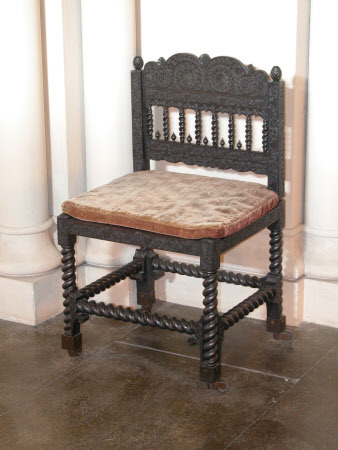Chair
Category
Furniture
Date
circa 1640 - 1680 (and later)
Materials
Ebony, cane and brass
Measurements
92.2 x 53.2 x 48 cm
Place of origin
Coromandel Coast
Order this imageCollection
Penrhyn Castle, Gwynedd
NT 1420722.2
Summary
A backstool, one of a set of ten turned and carved ebony cane-seated backstools, or chairs, Coromandel Coast, circa 1640-80. With minor difference in design, and all with modifications to the legs and later castors, probably made in the 1830s. Each having a shaped cresting rail carved with Indian flora above an arcade of eight spiral-turned, swelling spindles, spaced by seven onion-shaped finials, a shaped carved rail below and all between floral-carved uprights topped by foliate finials. Each with a cane seat in carved set rails and raised on four block- and spiral-turned legs joined by conforming foot stretchers.
Full description
Backstools, or chairs, like this, made of carved and turned ebony, were made in south-eastern India, in states bordering the Bay of Bengal on what is now called the ‘Coromandel’ Coast. Rich in natural resources, the area attracted European trading interest from the middle of the 17th century and this led to the emergence of a market in carved ebony furniture – heavily influenced by Dutch fashions – of which there are several examples in National Trust collections. These chairs are an interesting amalgam: the form, particularly the spiral-turned legs, is typically European, but the carved flowers are species indigenous to India and their abundance on these chairs typical of the 17th century Indian aesthetic. There are over fifty pieces of ebony furniture (from various places and of various dates) at Penrhyn - a house furnished by a fortune amassed from slave-owning in Jamaica - most of which were probably acquired around 1830 during the expansion and transformation of Penrhyn Castle by the architect Thomas Hopper (1776-1856) for George Hay Dawkins-Pennant (1764-1840). The legs of these chairs were probably made then: the castors are typical of the early 19th century. It has been said that no other group of ‘Indo-European’ furniture has been as misunderstood as this one. In England, they were made fashionable by Horace Walpole (1717-97), who believed that they were English, and even in the 20th century chairs of this type were being described as ‘Jacobean’ or ‘Indo-Portuguese’. The recent revival in scholarly interest in Indian furniture, however, has shown (using inventories of the Dutch East India Company) without doubt that the Coromandel Coast was the centre for production. Later examples were made in Sri Lanka and Jakarta, Indonesia.
References
Jaffer 2001 : Amin Jaffer, Furniture from British India and Ceylon, a catalogue of the collection in the Victoria and Albert Museum and the Peabody Essex Museum, London, V&A publications, 2001.
